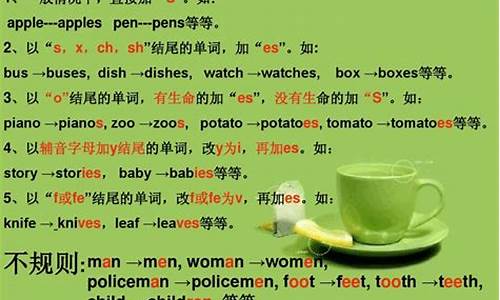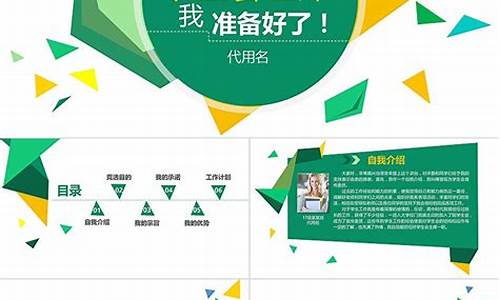您现在的位置是: 首页 > 文案大全 文案大全
句子是单数还是复数_句子是单数还是复数
tamoadmin 2024-08-13 人已围观
简介1.怎么判断动词是单数还是复数2.谓语动词单复数是什么3.英语?一个句子中名词什么时候用单数什么时候复数吖4.为什么有些句子谓语要看宾语是单数还是复数?5.单数句变复数句的规则口诀如:(1) Somebody is asking for you. 有人在找你。(2) Everyone is here. 大家都来了。(3) There is something wrong with my bike.
1.怎么判断动词是单数还是复数
2.谓语动词单复数是什么
3.英语?一个句子中名词什么时候用单数什么时候复数吖
4.为什么有些句子谓语要看宾语是单数还是复数?
5.单数句变复数句的规则口诀

如:(1) Somebody is asking for you. 有人在找你。(2) Everyone is here. 大家都来了。(3) There is something wrong with my bike. 没有的单车有点毛病。B.主语是I(除be 动词用am外) , you, we, they代词时,谓语动词用第三人称复数形式。如:(1) I like to stay here with you. 我喜欢跟你在这儿。(2) They are all soldiers. 他们都是战士。(3) We play football after school. 我们放学后踢足球。C.主语是:who, what, which, all, more, most, some, any, none, the rest, the remainder时,谓语动词的形式须依具体情况而定。如:(1) Who’s the girl over there? 那边的那个女孩是谁?(2) Who are the boys playing games there? 在那里做游戏的男孩子是哪些人?(3) What’s this? 这是什么?(4) What are those? 哪些是什么?(5) Which is yours? 哪一个是你的?(6) Which are children’s? 哪一些是孩子们的? 名词做主语A. 一般说来,不可数名词及可数名词的单数做主语时,谓语动词用第三人称单数形式。如:(1) Water is necessary for living things. 水对于生物来说是必须的。(2) The desk over there is Li Lei’s. 那边的那张课桌是李蕾的。(3) The dog is a useful animal. 狗是一种有用的动物。B. 表示总称意义的名词people (人们,人民), cattle, police,youth做主语时,谓语动词用第三人称复数形式。如:(1) English people are fond of talking about weather. 英国人喜欢谈论天气。(2) Cattle are farmers’friends. 牛是农民的朋友。C. 主语是:public, board, family, class, team, group, crowd, audience, company, crew, committee, enemy, , herd, jury, party等名词时,如果是作为整体的,谓语动词用第三人称单数形式;如果作为其中一个个的成员,谓语动词用第三人称复数形式。如:(1) Our class is made up of fifty students. 我们班有五十个学生组成。(2) Our class are working very hard. 我们班学习都很努力。(3) His team is very strong. 他们队很强大。(4) His team are talking with the . 他们队在跟教练谈话。D. 主语是:时间、距离、价格、度量衡单位等名词或短语,即使是复数,谓语动词也只能用第三人称单数形式。如:(1) Three years passes quickly. 三年很快过去了。(2) Two meters is not long enough. 两米不够长。E. 主语是:news, politics, physics, plastics, mathematics等名词虽然以—s结尾,但谓语动词也只能用第三人称单数形式。如:(1) Physics is very interesting and useful. 物理既很有趣也很有用。(2) Plastics is widely used in our daily life. 塑料在日常生活中被广泛地应用。F. 主语若是书名,剧名、报刊、杂志名称或国家、单位名称时,即使名词是复数形式,谓语动词也只能用第三人称单数形式。如:(1) The Arabian Nights is very interesting. 《一千零一夜》很有趣。(2) The New York Times is popular in America. 《纽约时报》在美国很受欢迎。G. 在算式里,主语是数词时,谓语动词也只能用第三人称单数形式。如:(1) Three and five is eight. 三加五等于八。(2) Twelve divided by six is two. 十二除以六等于二。H. 主语是:a lot of, lots of, plenty,百分比of +名词时,谓语动词的形式须依照名词的数而确定。如:(1) A lot of people he taken part in the activity. 很多人参加了这次活动。(2) Lots of water is lost. 大量的水被流失了。I. 主语是:kind of, type of, pair of, amount of, quantity of + 名词时,谓语动词的形式须依照kind, type, amount, pair, quantity的数而确定。如:(1) This pair of trousers was made by Master Li. 这条裤子是李师傅做的。(2) A large quantity of water in the sea has been polluted. 这个海里大量的水被污染了。(3) Large quantities of rice he been destroyed in the flood. 大量的庄稼在洪水中被毁坏了。J. 主语是:the number of + 名词的复数时,谓语动词用第三人称单数形式。如:The number of students in our class is seventy-eight. 我们班的学生数是七十八。 主语是:a number of + 名词复数时,谓语动词用第三人称复数形式。如:A number of students of our school come from the countryside. 我们学校很多学生来自农村。K. 主语是:the population时,谓语动词用第三人称单数形式。如:(1) What is the population of your town? 你们镇的人口多少?(2) The population of America is a little over two hundred million. 美国人口数大约是两亿多一点。 主语是:分数+ population时,谓语动词常用第三人称复数形式。如:About eighty percent of the population in our country are farmers. 我们国家大约有百分之八十的人口是农民。L. 主语是:means, works, sheep, fish, Japanese, Chinese等名词时,谓语动词的形式须依照它们在句中的意义来确定。如:(1) Every means has been tried but we can’t se him. 每一种方法我们都是用过了,但是我们还是救不了他。(2) All the means he been tried but we can’t se him. 所有的方法我们都是用过了,但是我们还是救不了他。M. 主与是:clothes, compasses, goods, glasses, trousers, scissors, shoes, socks, gloves等名时,谓语动词用第三人称复数形式。如:(1) The trousers are not expensive. 这条裤子不贵。(2) Your socks are over there. 你的袜子在那边。 两个或两个以上的名词连在一起做主语(一) and, both...and 连接名词或代词做主语A.谓语一般用复数形式。如:(1) Li Lei and Liu Mei are both interested in English. 李蕾和魏方都对英语感兴趣。(2) He and she are good friends. 他跟她是好朋友。B.and 连接的两个成对的名词,如fork and knife, bread and butter;soda and water;coffee and water;aim and end;salt and water等,虽有and 连接,但仍表示单一的概念,谓语动词常用第三人称单数形式。如:(1) Where is your fork and knife? 你的刀叉在哪儿?(2) Is the bread and butter enough for you two? 你们两人吃这一点面包和黄油够了吗?C.and 连接的两个名词若是指同一个人, 即:and前的名词前有冠词,而and后面的名词前没有冠词。谓语动词常用第三人称单数形式。如:I’m told that the monitor and League secretary is ill today. 我听说班长兼团支书今天病了。D.and所连接的连个名词前分别有: every, each, no, many a等修饰时,谓语动词用第三人称单数形式。如:(1) Every boy and every girl enjoys themselves in the school. 在学校,每一个男孩和女孩都玩得挺开心。(2) Many a teacher and many a student has spoken at the meeting. 在会上,很多老师和学生发了言。(二) 主语是:连接词or, either…or…, neither…nor…, whether…or…, not…but…, not only…but also…等连接的名词或代词时,谓语动词的形式须跟与之最接近的名词或代词决定。如:(1) Neither he nor you are to blame. 他和你都不应该受责备。(2) Is neither he nor you to blame? 他和你都不应该受责备吗?(三) 主语是:介词in, out of, with, except, besides, without, as well as, no less than, rather than, more than, but, along with, together with, like, including, in addition to等所连接的两个名词时,谓语动词的形式应与这些词前面的名词的数保持一致。如:(1) At the meeting, one in four is against the decision. 会上由四分之一的人反对这一决议。(2) The teacher with his students is discussing a question. 老师和学生们在讨论问题。(四) one and a half + 名词复数做主语,即名词超过一,但不满二时,谓语动词用第三人称单数形式。如:One and a half oranges is enough for the baby. 这个孩子有一个半桔子就够了。(五) many a + 名词单数;more than one + 名词单数;a + 名词单数+ or two等做句子的主语时,谓语动词用第三人称单数形式。如:(1) Many a student is interested in English grammar. 很多学生对英语语法感兴趣。(2) A worker or two is going to be sent to work abroad. 一两个工人将被派往国外去工作。(六) one or two +名词复数做句子的主语时,谓语动词第三人称复数形式。如:One or two spelling mistakes he been found in your composition. 在你的作文中发现了一两个拼写错误The + 形容词做主语A.The + 形容词指人做主语时,谓语动词一般用第三人称复数形式。如:(1) The poor were usually looked down upon by the rich. 过去,穷人常被富人瞧不起。(2) The wounded he been taken good care of in the hospital. 伤员在医院受到了很好的照护。B.The + 形容词指抽象概念做主语时,谓语动词一般用单数形式。如:The decayed has been thrown away. 腐烂的东西已经被扔掉了 主语是句子、短语A.主语是非谓语动词短语时,谓语动词用第三人称单数形式。如:(1) Reading is of much help for learning a language. 阅读对学语言很有帮助。(2) To keep on doing morning exercises is good. (= It is good to keep on doing morning exercises. ) 坚持做早操很有好处。B.主语是从句时,谓语动词一般用第三人称单数形式,如:(1) Why he was absent yesterday is being questioned. 他昨天为什么没来正在询问之中。(2) Where we can get so much money is still a problem. 我们到哪里去弄这么多钱还是个问题。 但what,who引导的从句做主语时,当指具体的东西或人时,谓语动词的形式必须根据具体的意思而定。如:What I want are these things.C.在强调句型“It + be + 被强调的部分+ that / who…”中,be总是用单数形式;that / who后的谓语动词的形式必须跟被强调的主语保持一致。如:(1) It was Lin Tao who called you just now. 刚才给你打电话的就是林涛。(2) It is you that are going to be invited to the party. 只有你将被邀请去参加聚会。D.定语从句中谓语动词的形式必须跟先行词的单、复数形式保持一致。如:(1) The girl who is speaking on the stage is Zhang Li’s sister. 在台上讲话的那个女孩是张力的姐姐。(2) The children that are playing games over there are from Hunan. 在那边做游戏的孩子们是湖南人。 注意:在“one of + 名词复数+ 定语从句”结构中,定语从句的谓语动词一般用第三人称复数形式,但当one前面有the, the very, the less, the only或形容词最高级修饰时,定语从句的谓语动词一般用第三人称单数形式,如:(1) Li Lei is one of the students who are good at English. 李蕾是英语学得好的学生之一。(2) Alice is the only one of the girls that is from America. 艾利斯是唯一的一个来美国的女孩。E.there be结构中be动词的形式由紧接近be后面的名词的形式所决定。如:(1) There is a teacher and seventy students in the classroom. 教室里有一个老师和七十个学生。(2) There are seventy students and a teacher in the classroom. 教室里有七十个学生和一个老师。F.在某些虚拟语气的句子中,无论主语是谁,be动词总是为were的形式。如:(1) If I were a bird, I would fly in the sky freely. 要是我是一只鸟,我将自由自在地在天空飞翔。
怎么判断动词是单数还是复数
The Chinese are a bre and hardworking people.
the Chinese ,people 都属于 集合名词,作主语时
谓语用复数形式。
谓语动词单复数是什么
谓语动词用不用“单三形式”,主要取决于句子的主语。
以下几种情况可以使用动词单三形式:
1、第三人称单数he ?she ?it ?做主语
2、非谓语动词(动词不定式,动名词)做主语
3、再就是比如时间,长度等作主语时当作单数来用
动词的第三人称单数形式(简称单三式)
1.一般在词尾加“-s”help-helps make-makes ride-rides know-knows
2.在s z x sh ch 结尾的词在词尾加“-es”push-pushes pass-passes watch-watches wash-washes
3.以“元音字母+y”结尾时,加“-s”;以“辅音字母+y”结尾时,变 y为i,再加“-es”play-plays stay-stays study-studies carry-carries
4.以“辅音字母+o”结尾的词,多数在词尾加“-es”go-goes do-does
5.be动词的单三式为is ?6.he动词的单三式为has
英语?一个句子中名词什么时候用单数什么时候复数吖
英语中,谓语动词必须与主语的人称和单复数保持一致的关系,即单数的主语必须用单数形式的谓语,而复数的主语必须用复数的谓语。
she is a student。
they are students。
第一个句子中的is就是谓语动词,用的是单数。
第二个句子中的are就是复数的谓语动词。
所谓的谓语动词就是用来做谓语的动词。
扩展资料:
一般来说没有谓语的句子是不完整的,由于谓语是说明主语的,所以没有谓语的例句就像个没头的苍蝇,让人觉得很乱,不知所云。但是有些句子中谓语是可以省略的,比如感叹句,What a silly thing (you he done)!括号内的是句子的主语和谓语部分均可省略。
动词可充当非谓语和谓语,充当谓语即谓语动词. 谓语动词在形态变化上受主语的限制,有人称和数的变化,它是一个句子或一个从句中不可缺少的一部分。
百度百科-谓语动词
为什么有些句子谓语要看宾语是单数还是复数?
名词用单数还是复数,取决于2个原因.1就是看物体是单个还是多个,若多个的话当然就是复数啦!如果只有1个就用单数咯.2看物体是不是可数名词或者是不可数名词.如果是不可数名词的话就不用复数,因为不可数的嘛!判断某名词是可数名词还是不可数名词时,可先将这个名词所表示的东西一分两半,若每一半不能再叫原来的名称时,这个名词就是可数名词;反之,若每一半还可以叫原来的名称时,这个名词就是不可数名词。例如,desk表示“课桌”。若将课桌一分两半,所得的两部分都不再具有课桌的特征,不能再用desk一词来表示。因此,desk是可数名词。meat表示“肉”。将一块肉一分两块,所得的两块仍可以称作肉。所以,meat是不可数名词。
单数句变复数句的规则口诀
1.the following are suggestions from the teachers
2.the following is the composition the teacher wrote
the following在前面时,
谓语动词由后面的名词决定
就像there be一样
be动词由后面的名词决定一样
单数句变复数句的规则口诀如下:
名词单数变复数,直接加-s占多数,s、x、z、ch、sh来结尾,直接加上-es,词尾是f或fe,加-s之前先变ve,辅母+y在词尾,把y变i再加-es,词尾字母若是o,常用三个已足够,要加-es请记好,hero、tomato、potato。
主语的变化
在单数句子中,主语通常是一个单一的名词或代词。在变为复数句子时,主语需要变成复数形式,通常是加上-s或-es。
例句1:The girl is wearing a red dress.(单数句子)
复数句子:The girls are wearing red dresses.(复数句子)
谓语的变化
谓语是用来描述主语的动作或状态的。在单数句子中,谓语动词的形式通常与主语保持一致。在变为复数句子时,谓语动词需要变成复数形式,通常是加上-s或-es。
例句2:John likes to read books.(单数句子)
复数句子:John and Mary like to read books together.(复数句子)
宾语的变化
在单数句子中,宾语通常是名词或代词。在变为复数句子时,如果宾语是可数名词,需要变成复数形式。如果宾语是不可数名词,则不需要变化。
例句3:I want to buy a book.(单数句子)
复数句子:We want to buy several books.(复数句子)
定语的变化
定语是用来修饰名词或代词的。在单数句子中,定语通常是形容词或名词。在变为复数句子时,定语也需要变成复数形式。
例句4:The car is blue.(单数句子)
复数句子:The cars are blue.(复数句子)









